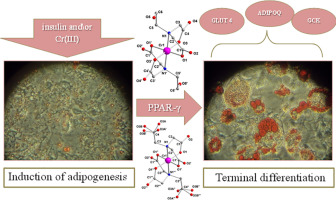Journal of Inorganic Biochemistry ( IF 3.8 ) Pub Date : 2018-02-10 , DOI: 10.1016/j.jinorgbio.2018.02.001 O. Tsave , C. Gabriel , M. Kafantari , M. Yavropoulou , J.G. Yovos , C.P. Raptopoulou , V. Psycharis , A. Terzis , C. Mateescu , A. Salifoglou

|
In an attempt to understand the aqueous interactions of Cr(III) with low-molecular mass physiological ligands and examine its role as an adipogenic metallodrug agent in Diabetes mellitus II, the pH-specific synthesis in the binary-ternary Cr(III)-(HA = hydroxycarboxylic acid)-(N,N)-aromatic chelator (AC) (HA = 2-hydroxyethyl iminodiacetic acid/heidaH2, quinic acid; AC = 1,10-phenanthroline/phen) systems was pursued, leading to four new crystalline compounds. All materials were characterized by elemental analysis, UV–Visible, FT-IR, and ESI-MS spectroscopy, cyclic voltammetry, and X-Ray crystallography. Concurrently, the aqueous speciation of the binary Cr(III)-(2-hydroxyethyl iminodiacetic acid) system, complemented by ESI-MS, provided key-details of the species in solution correlating with the solid-state species. The structurally distinct Cr(III) soluble species were subsequently used in an in vitro investigation of their cytotoxic activity in 3T3-L1 fibroblast cultures. Compound 1 exhibited solubility, bioavailability, and atoxicity over a wide concentration range (0.1–100 μΜ) in contrast to 3, which was toxic. The adipogenic potential of 1 was subsequently investigated toward transformation of pre-adipocytes into mature adipocytes. Confirmation of that capacity relied on molecular biological techniques a) involving genes (glucose transporter type 4, peroxisome proliferator-activated receptor gamma, glucokinase, and adiponectin) serving as sensors of the transformation process, b) comparing the Cr(III)-adipogenicity potential to that of insulin, and c) exemplifying the ultimate maturity of adipocytes poised to catabolize glucose. The collective effort points out salient structural features in the coordination sphere of Cr(III) inducing adipogenic transformation relevant to combating hyperglycemia. The multiply targeted mechanistic insight into such a process exemplifies the role of well-defined Cr(III) complex forms as potential insulin-mimetic adipogenic agents in Diabetes mellitus II.
中文翻译:

二元三元Cr(III)-羟基羧酸-芳香族螯合剂体系的合成研究。结构特异性影响与胰岛素模仿相关的成脂生物标志物
为了理解Cr(III)与低分子量生理配体的水相互作用并检验其作为糖尿病II中成脂金属药物的作用,二元三元Cr(III)-(-)中的pH特异性合成HA =羟基羧酸)-(N,N)-芳族螯合剂(AC)(HA = 2-羟乙基亚氨基二乙酸/ heidaH 2奎宁酸; 追求AC = 1,10-菲咯啉/ phen)系统,从而产生了四个新的结晶化合物。所有材料均通过元素分析,紫外可见光,FT-IR和ESI-MS光谱,循环伏安法和X射线晶体学进行了表征。同时,由ESI-MS补充的二元Cr(III)-(2-羟乙基亚氨基二乙酸)系统的水物种形成提供了与固态物种相关的溶液中物种的关键细节。随后将结构独特的Cr(III)可溶性物质用于3T3-L1成纤维细胞培养物中细胞毒性活性的体外研究。与3相比,化合物1在较宽的浓度范围(0.1–100μM)内表现出溶解度,生物利用度和无毒性。,这是有毒的。1的成脂潜能随后研究了将前脂肪细胞转化为成熟脂肪细胞的方法。这种能力的确定依赖于分子生物学技术,a)涉及作为转化过程传感器的基因(葡萄糖转运蛋白4型,过氧化物酶体增殖物激活的受体γ,葡萄糖激酶和脂联素),b)比较Cr(III)-成脂潜力c)举例说明准备分解代谢葡萄糖的脂肪细胞的最终成熟度。集体的努力指出了在Cr(III)的协调领域中,与抗高血糖有关的显着结构特征,可诱导成脂转化。











































 京公网安备 11010802027423号
京公网安备 11010802027423号